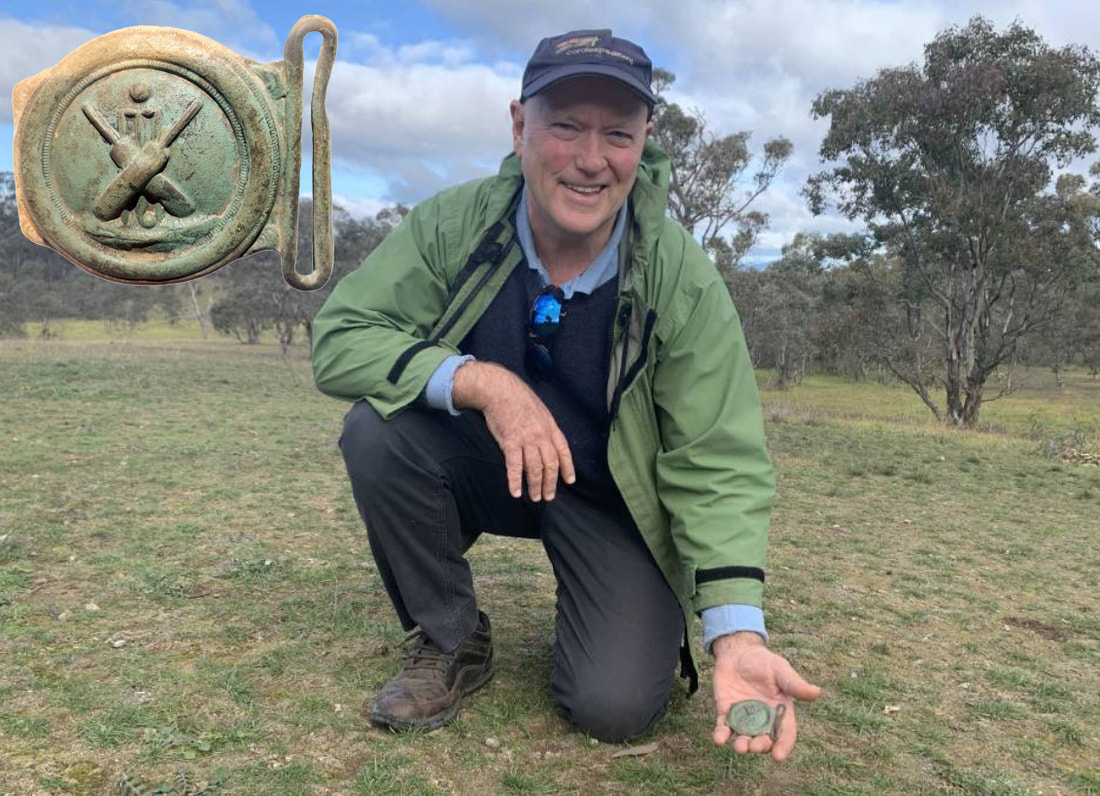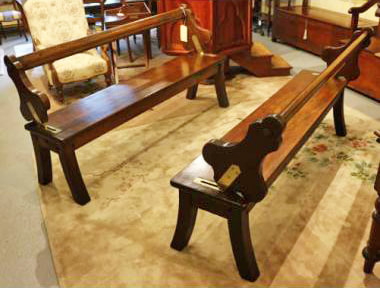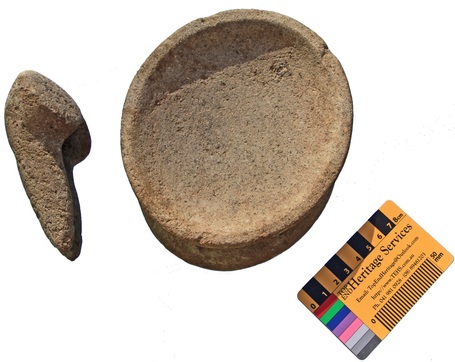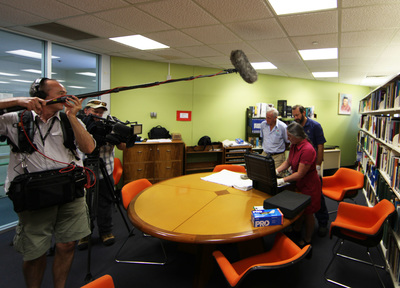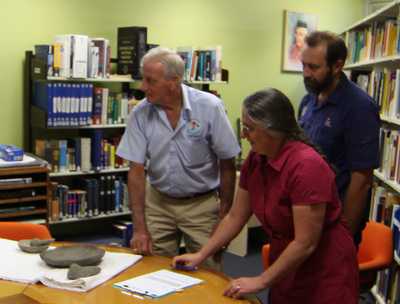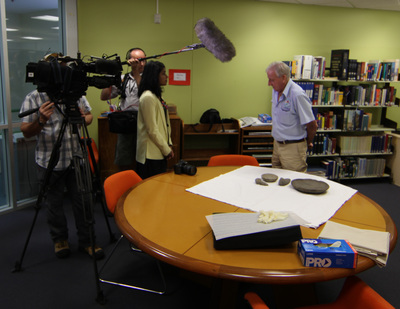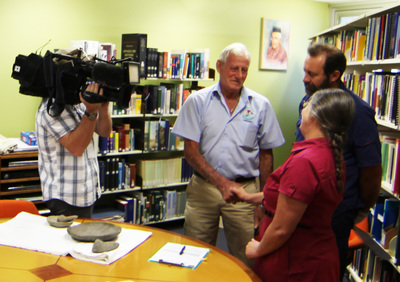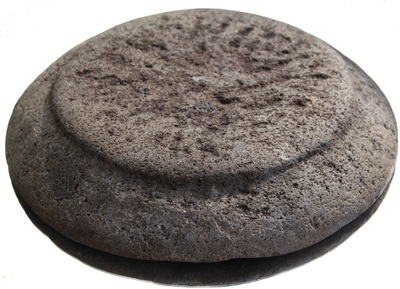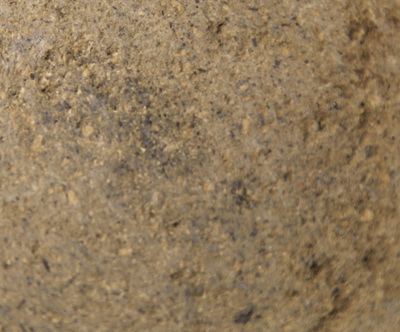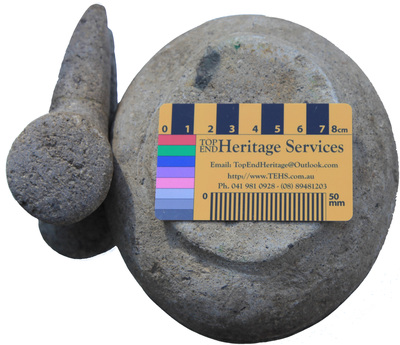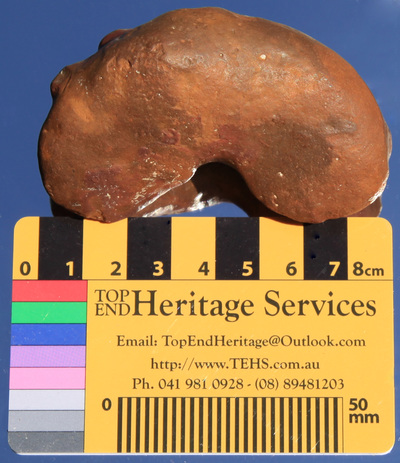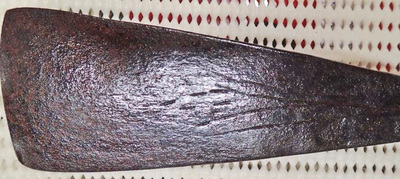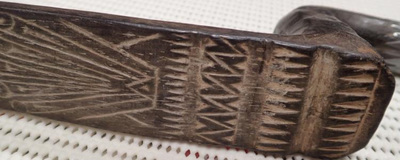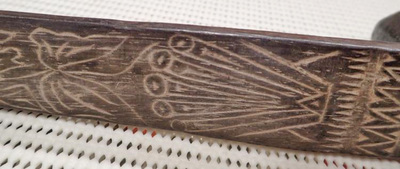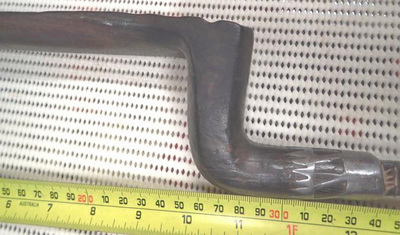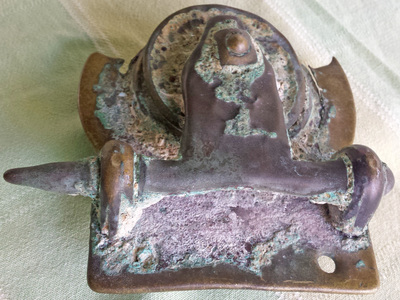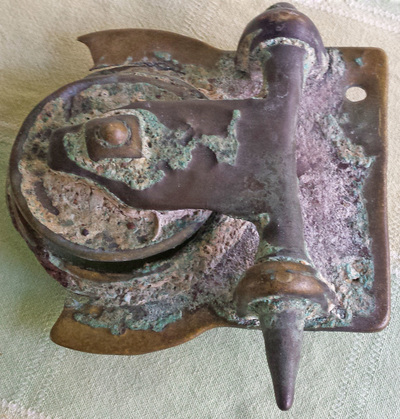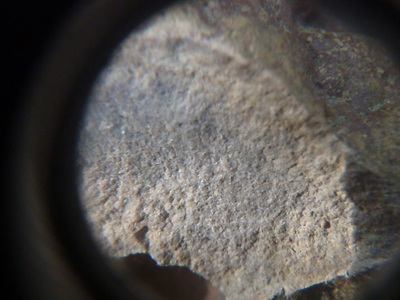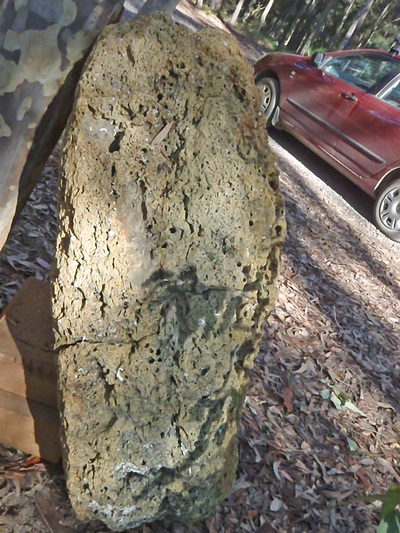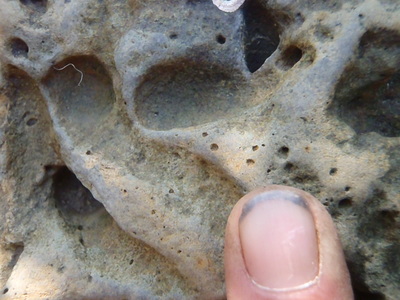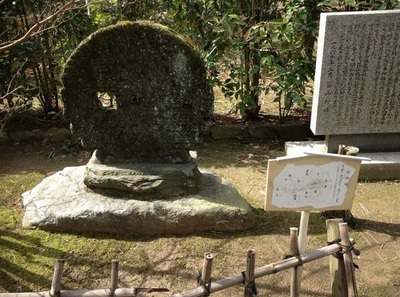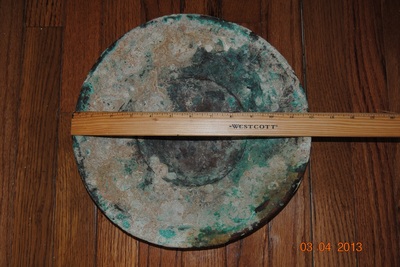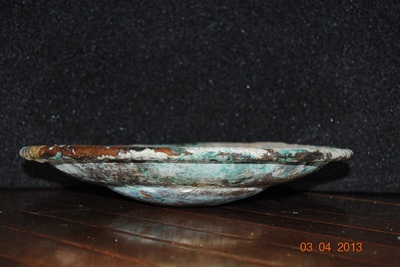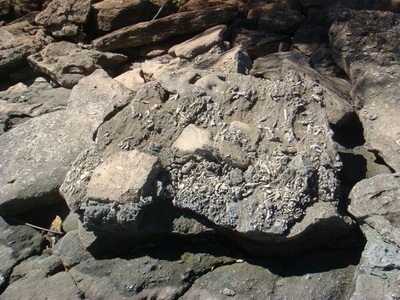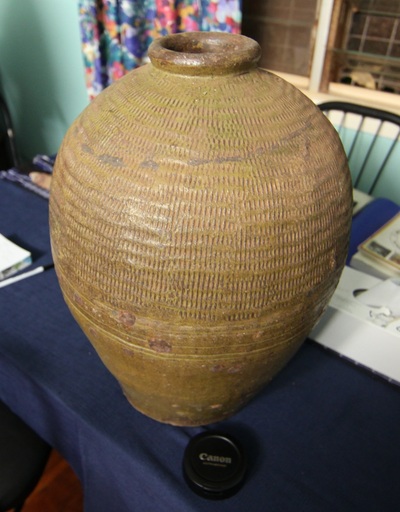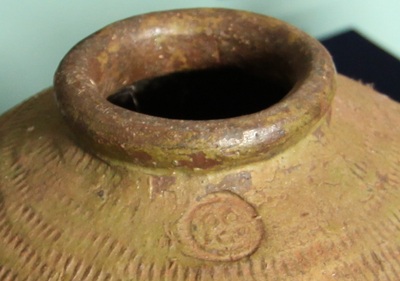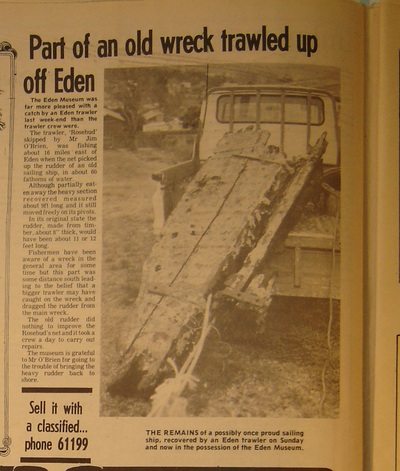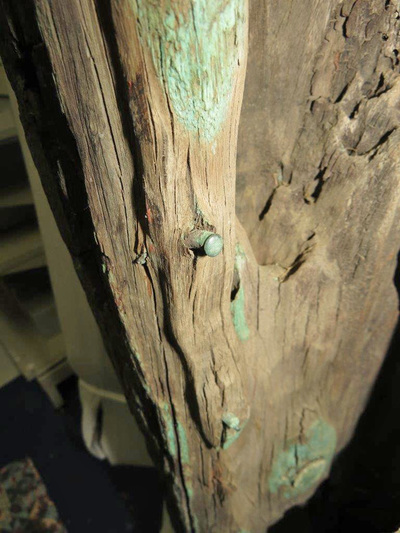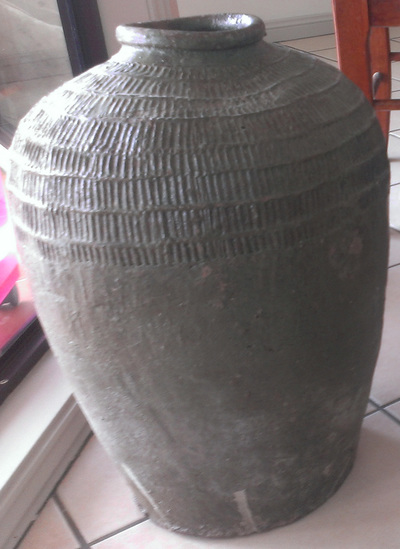Past Masters Mystery Objects
1860s Cricket Buckle
PastMaster Mike Hermes made this discovery whilst walking the Crace Grasslands near Canberra. This rare 1860s Cricket Buckle is on it's way to the Bradman Museum at Bowral as detailed in the Canberra Times article below.
Catalina Mooring Blocks
The proprietors of HY Hire found these in their tipper about 8 years ago and as the 3.5 ton forklift wasn't up to the job of shifting them they've stayed on the kerbside ever since. Nobody has claimed them and despite being over the road from the Aviation Museum, no-one has inquired about them before. The concrete is very well made with good quality blue metal inclusions evenly spaced and the only shell is on the outside. The two conical mooring blocks have round bar anchoring the admiralty pattern chain and the two square blocks have large deformed Rebar. The concrete on all 4 blocks is identical.
From Simon Strickett
These objects are adjacent to the site of Mr Perriman's repurposing of a paddlewheel off the wreck of the Young Australian in the Roper River. He used it to pump water up to the old Emerald Mission gardens & timber mill before the cyclone skittled the show and the mission moved .25 mile away.
Simon found these mystery objects on the north side of the Angurugu River and says he's not sure of the type of metal, "it was pliable and had a blue stain so maybe copper and lead or copper and zinc."
More from MH's Shack's Shed
The image (above left) of the bench on the tall ship James Craig gave the clue but you wouldn't want those things flapping around in a high sea & there was always the issue of that iron bolt. The solution is the ’Government Railway Reversible Kauri Pine Bench Seats, made by HT Jones & Son of Paramatta, and bearing their paper label to the underside of seat. Each seat also bears a government inventory stamp for 1899.’ Height: 91 cm Width: 183 cm Depth: 39 cm. This fine brace of said benches was sold recently by 'The Merchant of Welby' Antiques NSW.
From Mike Hermes' Shed
Covid19 has driven PastMasters' archaeologist & educator Michael Hermes to delve into dark & rarely visited areas in search of artefacts. His description is illuminating - "This object is around 2 metres long, and the 30 cm x 5cm wide board pivots and slides on the end pieces on good quality bronze fixings. It has a 'boaty' feel about it. The thing is very heavy and the timber is hardwood. It was salvaged from a nineteenth century guest house shed some years ago, to inhabit my shed now. The guest house shed had lots of boat gear in it." The Guest House was in the Jervis Bay area of the ACT.
The first item to emerge, blinking in the unaccustomed sunlight was a very nice 'early convict mattock/hoe' with a very old & possibly original helve which is unusually long even at 0.75 Hermes. It has now been retired from drain cleaning duties.
Wessel Islands Pestle & Mortar
 SE Asian Ulekan & Cobek
SE Asian Ulekan & Cobek
They were found in the Wessel Islands by James Douglas McQueen, ashore from a RAN Patrol Boat in the mid-1970's - in a sand dune - beside a Tamarind tree skittled in a storm. Macassans often left boiling pots beneath Tamarinds but no such pestle and mortar has ever been found in Australia. It is proposed that when funds become available the carbon residue be C14 dated and the residue in the fabric also be examined as much can be learned. If some antiquity is indicated then XRD may reveal the origin of the stone. Typologically they are SE Asian, Stone Mortar & Pestle (Ulekan & Cobek) widely used throughout Indonesia and Thailand.
The finder was lost at sea and it is the wish of his family that they be researched and placed on permanent display in the Northern Territory. It is anticipated that they may be displayed with other Territory Treasures such as the Boustead Jar and the Doukas Dundee Swivel Gun at the up-coming lecture and artefacts roadshow at MAGNT on 15th July.
The finder was lost at sea and it is the wish of his family that they be researched and placed on permanent display in the Northern Territory. It is anticipated that they may be displayed with other Territory Treasures such as the Boustead Jar and the Doukas Dundee Swivel Gun at the up-coming lecture and artefacts roadshow at MAGNT on 15th July.
It is not possible to say much about the items except that they are well made - the larger one is composed of a more robust fabric as is seen from the pestles below, even though the smaller might be expected to perform the finer processing. The cavities may yield useful contents for analysis. The convex cheeks of the pestles conform sympathetically to the concave drift of their respective mortars and a close symmetry has been achieved. There is evidence of considerable wear through use by a right-handed person. It is suggested that the deep & crude incisions to the base of both mortars is an end-user modification for maritime conditions where the vagrancy of large stone objects is discouraged.
The images below show the ABC TV coverage of the donation of the mortaria to MAGNT in 22 June 2016 in the Peter Spillett Library at the museum.
The explicit conditions attached to this donation to MAGNT were the dying wishes of the donor. That the mortaria would be researched, the residue analysed and the items placed on public display attributed to his late brother James McQueen - the finder. Despite 'on camera' assurances and handshakes none of the undertakings has been fulfilled as of April 2020.
Tiwi Islands' Fossils
These fossils will be part of a display for school children initially and any assistance with identifying the likely source objects would be greatly appreciated.
The Eden Ewer
Weapon or Tool
Crimson Mist Military Antiques is displaying this unidentified item - SWD244 Antique fighting implement or whaling item. Unknown - could be an antique Eskimo item or on the other side of the world an African or Islander tool or weapon, Iron, wood & silver construction. One end is carved wood, the other is a chisel shaped device with a decorated steel shaft & a flat cutting blade, silver mount handle, in the hand it sits like the wood goes along under the forearm to be used to block a blow & the blade to attack with or wood sits under forearm as per above for ease of using it as a tool - might be something?
http://www.cmmilitaryantiques.com/gallery.php?arid=11112 Crimson Mist Military Antiques
http://www.cmmilitaryantiques.com/gallery.php?arid=11112 Crimson Mist Military Antiques
Fraser Island Lead Weight

The mystery of the Fraser Island lead weight continues!
Now at the University of Queensland Museum, this object was found at Hook Point on the southern end of the island in 1976 175m inland from the current beach at a depth of between 2.2 and 2.4m.
Dating of Loisels pumice associated with it suggests a deposit date of between 1410 and 1627 (Ward et. al 1999).
Analysis of lead isotope values suggested that the lead was mined in France (Ward and Gulson 2004).
For further reference see:
Ward et al (1999) "Ancient lead weight found with Loisels Pumice near Hook Point, Fraser Island, Queensland", Archaeology in Oceania 34(1): 25-30
Ward, W.T. and B.L. Gulson (2004) "Lead weight from Fraser Island compared with sources in France and China", Archaeology in Oceania 39(1): 52-53
Now at the University of Queensland Museum, this object was found at Hook Point on the southern end of the island in 1976 175m inland from the current beach at a depth of between 2.2 and 2.4m.
Dating of Loisels pumice associated with it suggests a deposit date of between 1410 and 1627 (Ward et. al 1999).
Analysis of lead isotope values suggested that the lead was mined in France (Ward and Gulson 2004).
For further reference see:
Ward et al (1999) "Ancient lead weight found with Loisels Pumice near Hook Point, Fraser Island, Queensland", Archaeology in Oceania 34(1): 25-30
Ward, W.T. and B.L. Gulson (2004) "Lead weight from Fraser Island compared with sources in France and China", Archaeology in Oceania 39(1): 52-53
The Geelong Keys |
|
| ||||||||||||
Charles La Trobe and the Geelong Keys By Murray Johns
Abstract
Five keys were found in an excavation several metres deep at Geelong in 1847. Superintendent La Trobe’s interpretation of how they got there and how old they were formed the basis of the ‘Geelong Keys’ story. In 1977, Kenneth McIntyre used that story to support his hypothesis that the Portuguese discovered Australia around 1522. The story is re-examined here in the light of new evidence.
Abstract
Five keys were found in an excavation several metres deep at Geelong in 1847. Superintendent La Trobe’s interpretation of how they got there and how old they were formed the basis of the ‘Geelong Keys’ story. In 1977, Kenneth McIntyre used that story to support his hypothesis that the Portuguese discovered Australia around 1522. The story is re-examined here in the light of new evidence.
TJ's Mystery Valve Plate - 170mm x 130mm

Trevor Anderson wrote - "I found this bronze valve off the northern side of Cook Island (NSW) in the 1990's. A cannon was also found there in the 1950's and auctioned off after the owner passed away. Since British settlement of Australia, a number stories about mysterious pre-Cook shipwrecks in Queensland have circulated and a number of prominent Australian historians have questioned the claim that Captain Cook was the first European to discover Queensland.
There is historic evidence that Captain Cook used Portuguese or Spanish maps such as recalled in the Dauphin, Dieppe, Vallard and Desceliers maps to aid his navigation of the Pacific and Australia's east coast.
There is historic evidence that Captain Cook used Portuguese or Spanish maps such as recalled in the Dauphin, Dieppe, Vallard and Desceliers maps to aid his navigation of the Pacific and Australia's east coast.

I was told by a local store owner (Chinderah Maritime Museum) that Captain Cook had noticed a wreck on the northern side of Cook Island while anchored on the southern side of Cook Island. Cook mentioned that this wreck had been there for at least 50 years. I cannot find anything to back up this report.
{Ray Parkin's HM Bark Endeavour - chart p. 218 - Ship's Log, Cook, Banks & Parkinson Diaries for Wednesday 16th May 1770 pages 222 & 223 - off Fingal Head Cook wrote of seeking the breakers 'stretch off East two Leagues from a point under which is a small island.'} My bronze valve could have come from one of many shipwrecks listed below.
{Ray Parkin's HM Bark Endeavour - chart p. 218 - Ship's Log, Cook, Banks & Parkinson Diaries for Wednesday 16th May 1770 pages 222 & 223 - off Fingal Head Cook wrote of seeking the breakers 'stretch off East two Leagues from a point under which is a small island.'} My bronze valve could have come from one of many shipwrecks listed below.

Following a suggestion by Marine Architect Noel Riley of a non-return valve for liquid - perhaps from 'the bilge pumping system which would have been pretty basic'. This part of the bilge-pump assembly was recovered from the wreck of the Stromberg which went down in 1855 at Curdies Inlet - whilst the master 'Bully' Forbes was below decks entertaining lady passengers. The lead housing explains the lip & the axle spike enables inspection to ensure that the non-return valve is working freely.
http://victoriancollections.net.au/organisations/flagstaff-hill-maritime-village?q=valve
Item 5465 is in the collection of the Flagstaff Hill Maritime Village, Warrnambool, Victoria.
http://victoriancollections.net.au/organisations/flagstaff-hill-maritime-village?q=valve
Item 5465 is in the collection of the Flagstaff Hill Maritime Village, Warrnambool, Victoria.
Shipwrecks - Tweed River NSW/QLD
Coolangatta
(1846) 88 ton Brig, lost North of the tweed River
. (sailing ship) Rose
(1846) Tweed Bar
Fanny
Morris (1848) Wrecked on Tweed Bar
Jane
(1848) Tweed bar
Jane
Scott (1849) Cook
Island
Comet
(1851) 34 ton schooner lost Tweed Bar
Favorite
(sic) (1857) Wrecked on Tweed Bar
Arrow
(1859) 125 ton Brigantine ran aground off the Tweed Bar.
Ebenezer (1859) Tweed bar (schooner) Koh-I-Noor (1859) Tweed Bar Fanny (1862) Tweed bar - struck Point Danger
Minerva (1866) Wrecked on Tweed River Flirt (1875) Wrecked on Tweed Bar
Settlers Friend (1877) 65 ton schooner wrecked at the Tweed Bar
Dollar Bird (1884) Tweed Bar. (transport schooner) Kalara (1886) Tweed Bar Reliance (1887) Tweed River
Collector (1887) 24 ton Paddle Steamer, wrecked on the Tweed Bar (steam)
Tweed (1888) Steel single screw steamer. Wrecked at entrance to Tweed River
Heroine (1897) 123 ton Schooner, Built in 1894 ran aground Danger Bay, Coolangatta
Chindera (1896) Lost off the Tweed River Bar (passenger/cargo ship) Annie (1903) Lost on the Tweed Bar (steam)
Fido (1907) Fido Reef near Cook Island (steam passenger/cargo ship)
Murwillumbah (1911) Tweed Bar Frendship (1912) Wrecked Tweed bar Terranora (1933) Ran aground off the Tweed River
Ebenezer (1859) Tweed bar (schooner) Koh-I-Noor (1859) Tweed Bar Fanny (1862) Tweed bar - struck Point Danger
Minerva (1866) Wrecked on Tweed River Flirt (1875) Wrecked on Tweed Bar
Settlers Friend (1877) 65 ton schooner wrecked at the Tweed Bar
Dollar Bird (1884) Tweed Bar. (transport schooner) Kalara (1886) Tweed Bar Reliance (1887) Tweed River
Collector (1887) 24 ton Paddle Steamer, wrecked on the Tweed Bar (steam)
Tweed (1888) Steel single screw steamer. Wrecked at entrance to Tweed River
Heroine (1897) 123 ton Schooner, Built in 1894 ran aground Danger Bay, Coolangatta
Chindera (1896) Lost off the Tweed River Bar (passenger/cargo ship) Annie (1903) Lost on the Tweed Bar (steam)
Fido (1907) Fido Reef near Cook Island (steam passenger/cargo ship)
Murwillumbah (1911) Tweed Bar Frendship (1912) Wrecked Tweed bar Terranora (1933) Ran aground off the Tweed River
The Eden Wheel Stone
Polite Suggestions
Disaster Bay Cannonball
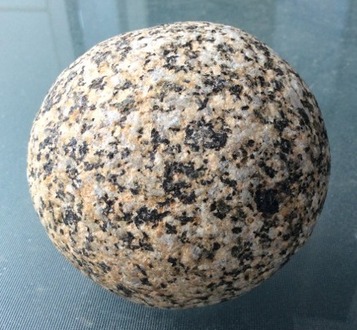
Campbell Macknight has passed on this enquiry from Richard Eggleton who writes "A nearly spherical "granite" object, was found in 1985 in a wash at the tree-line at Disaster Bay NSW.
The ball is not perfectly round, its greatest diameter is 10.1 cm, its least is 9.5 cm and the average is 9.8 cm. It is slightly pitted to a depth of at most 1 mm, mainly at biotite clusters, and there are high points at quartz aggregates, mostly standing no more than 0.5 mm above the adjacent feldspar.
There are two adhering materials, one is red-brown, soft, organic (by SEM) occurring in a 1 cm2 patch and a few smaller spots. The other is white, chalky, about 5 x 10 mm.
It weighs 1,268 g, with a density of 2.65 g/ml. This is the mid-range for a granite. 2.6 to 2.7 normally quoted.
It is a relatively fine-grained granodorite, maximum crystal size about 10 mm (plagioclase, quartz aggregates). It shows no foliation or gneissic fabric. About 40% (essentially one half) seems to be more Fe-stained than the rest - perhaps indicating a period partly buried.
The rock is not local based on its mineralogy (40% quartz, 34% plagioclase, 22% biotite, 4% muscovite) and approximate chemical composition. Probably the nearest similar granite is up in the Monaro, but so far this aspect has not been investigated very fully.
The feldspars are pitted (micron scale) and altered partly to clay. The biotite looks pristine.
Geologists are of the opinion that the shape did not result from natural processes.
More invasive investigations await opinion as to whether it is of any significance.
I would be grateful for any advice about how it got there and what it might be.
The finder surmises it is a cannonball."
Comment
Stone round shot were widely used, being cheap and readily available at sieges. The tendency to fragment was useful in an anti-personnel application. Stone would make safe ballast - the flat spot is often reported and a necessary feature for stacking, especially in maritime engagements. If anyone comes across sensible research on iron & stone projectiles please advise.
The ball is not perfectly round, its greatest diameter is 10.1 cm, its least is 9.5 cm and the average is 9.8 cm. It is slightly pitted to a depth of at most 1 mm, mainly at biotite clusters, and there are high points at quartz aggregates, mostly standing no more than 0.5 mm above the adjacent feldspar.
There are two adhering materials, one is red-brown, soft, organic (by SEM) occurring in a 1 cm2 patch and a few smaller spots. The other is white, chalky, about 5 x 10 mm.
It weighs 1,268 g, with a density of 2.65 g/ml. This is the mid-range for a granite. 2.6 to 2.7 normally quoted.
It is a relatively fine-grained granodorite, maximum crystal size about 10 mm (plagioclase, quartz aggregates). It shows no foliation or gneissic fabric. About 40% (essentially one half) seems to be more Fe-stained than the rest - perhaps indicating a period partly buried.
The rock is not local based on its mineralogy (40% quartz, 34% plagioclase, 22% biotite, 4% muscovite) and approximate chemical composition. Probably the nearest similar granite is up in the Monaro, but so far this aspect has not been investigated very fully.
The feldspars are pitted (micron scale) and altered partly to clay. The biotite looks pristine.
Geologists are of the opinion that the shape did not result from natural processes.
More invasive investigations await opinion as to whether it is of any significance.
I would be grateful for any advice about how it got there and what it might be.
The finder surmises it is a cannonball."
Comment
Stone round shot were widely used, being cheap and readily available at sieges. The tendency to fragment was useful in an anti-personnel application. Stone would make safe ballast - the flat spot is often reported and a necessary feature for stacking, especially in maritime engagements. If anyone comes across sensible research on iron & stone projectiles please advise.
| |||||||
Hawaiian Copper Disc
We have been approached by US Navy Diver Mike Pangburn about an interesting find that he made in the 1970s in 150 feet of seawater off Barbers Point, Oahu, Hawaii, about 12-30 miles offshore. The sea bottom was nothing but sand. The object was tested with a Nitron hand held metal tester and found to be 99.9% copper. Mike seeks help in its identification.
Gove Grid
Assay in the local bauxite mine labs showed metal to be bronze.
The Eden Rudder
The Discovery Bay Jars
The banner image shows East Woody Island at Nhulunbuy in NE Arnhem Land - the Casuarina was exposed when the sandbar migrated to the other side.
